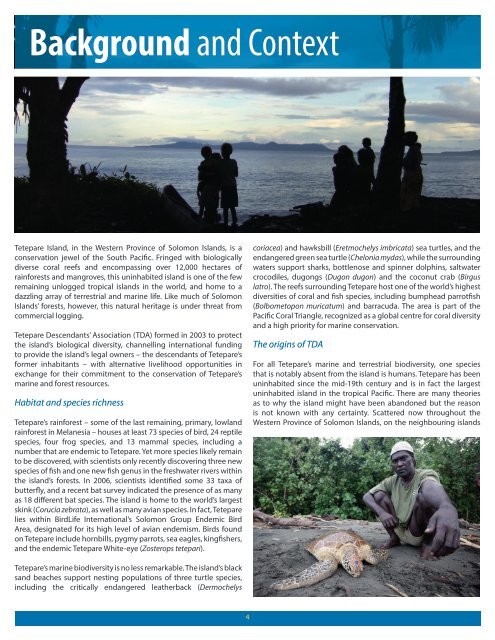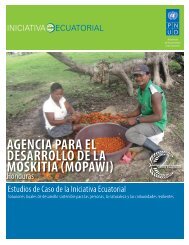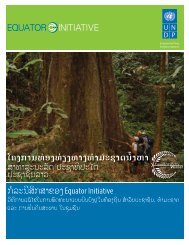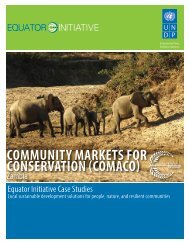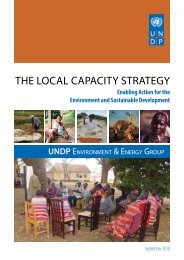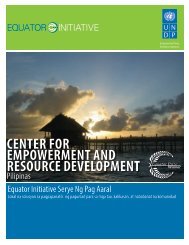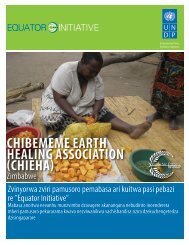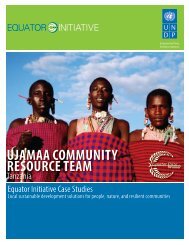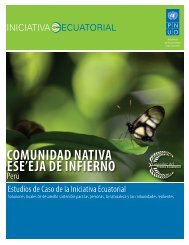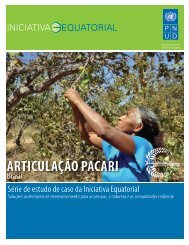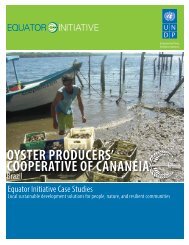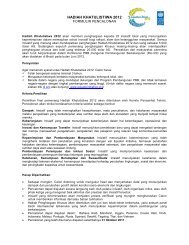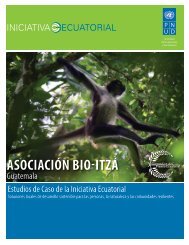Tetepare Descendants' Association (TDA) - Equator Initiative
Tetepare Descendants' Association (TDA) - Equator Initiative
Tetepare Descendants' Association (TDA) - Equator Initiative
You also want an ePaper? Increase the reach of your titles
YUMPU automatically turns print PDFs into web optimized ePapers that Google loves.
Background and Context<br />
<strong>Tetepare</strong> Island, in the Western Province of Solomon Islands, is a<br />
conservation jewel of the South Pacific. Fringed with biologically<br />
diverse coral reefs and encompassing over 12,000 hectares of<br />
rainforests and mangroves, this uninhabited island is one of the few<br />
remaining unlogged tropical islands in the world, and home to a<br />
dazzling array of terrestrial and marine life. Like much of Solomon<br />
Islands’ forests, however, this natural heritage is under threat from<br />
commercial logging.<br />
<strong>Tetepare</strong> Descendants’ <strong>Association</strong> (<strong>TDA</strong>) formed in 2003 to protect<br />
the island’s biological diversity, channelling international funding<br />
to provide the island’s legal owners – the descendants of <strong>Tetepare</strong>’s<br />
former inhabitants – with alternative livelihood opportunities in<br />
exchange for their commitment to the conservation of <strong>Tetepare</strong>’s<br />
marine and forest resources.<br />
Habitat and species richness<br />
<strong>Tetepare</strong>’s rainforest – some of the last remaining, primary, lowland<br />
rainforest in Melanesia – houses at least 73 species of bird, 24 reptile<br />
species, four frog species, and 13 mammal species, including a<br />
number that are endemic to <strong>Tetepare</strong>. Yet more species likely remain<br />
to be discovered, with scientists only recently discovering three new<br />
species of fish and one new fish genus in the freshwater rivers within<br />
the island’s forests. In 2006, scientists identified some 33 taxa of<br />
butterfly, and a recent bat survey indicated the presence of as many<br />
as 18 different bat species. The island is home to the world’s largest<br />
skink (Corucia zebrata), as well as many avian species. In fact, <strong>Tetepare</strong><br />
lies within BirdLife International’s Solomon Group Endemic Bird<br />
Area, designated for its high level of avian endemism. Birds found<br />
on <strong>Tetepare</strong> include hornbills, pygmy parrots, sea eagles, kingfishers,<br />
and the endemic <strong>Tetepare</strong> White-eye (Zosterops tetepari).<br />
coriacea) and hawksbill (Eretmochelys imbricata) sea turtles, and the<br />
endangered green sea turtle (Chelonia mydas), while the surrounding<br />
waters support sharks, bottlenose and spinner dolphins, saltwater<br />
crocodiles, dugongs (Dugon dugon) and the coconut crab (Birgus<br />
latro). The reefs surrounding <strong>Tetepare</strong> host one of the world’s highest<br />
diversities of coral and fish species, including bumphead parrotfish<br />
(Bolbometopon muricatum) and barracuda. The area is part of the<br />
Pacific Coral Triangle, recognized as a global centre for coral diversity<br />
and a high priority for marine conservation.<br />
The origins of <strong>TDA</strong><br />
For all <strong>Tetepare</strong>’s marine and terrestrial biodiversity, one species<br />
that is notably absent from the island is humans. <strong>Tetepare</strong> has been<br />
uninhabited since the mid-19th century and is in fact the largest<br />
uninhabited island in the tropical Pacific. There are many theories<br />
as to why the island might have been abandoned but the reason<br />
is not known with any certainty. Scattered now throughout the<br />
Western Province of Solomon Islands, on the neighbouring islands<br />
<strong>Tetepare</strong>’s marine biodiversity is no less remarkable. The island’s black<br />
sand beaches support nesting populations of three turtle species,<br />
including the critically endangered leatherback (Dermochelys<br />
4


